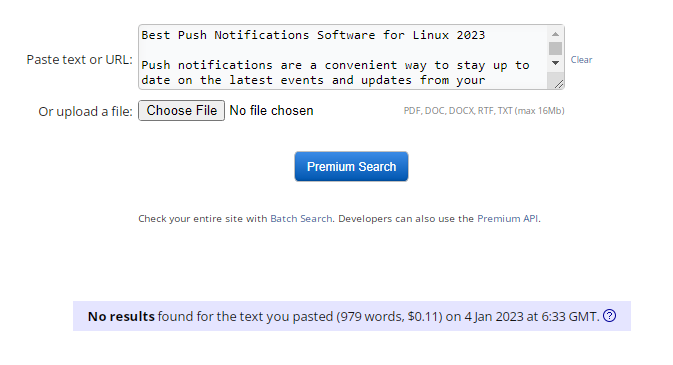
Push notifications are a convenient way to stay up to date on the latest events and updates from your favorite apps and services. They allow you to receive notifications on your desktop or mobile device even when the app or service isn’t actively running.
If you’re a Linux user, you may be wondering which push notification software is the best for your system.
In this blog post, we’ll be taking a look at the top 5 push notification software for Linux in 2023. But before we dive into the list, let’s go over some key considerations to keep in mind when choosing push notification software for Linux.
5 Things to Consider When Choosing Push Notification Software for Linux
Here are 5 things that you may want to take into account while deciding on what push notification software to choose for Linux.
- Compatibility with different Linux distributions. Make sure the push notification software you choose is compatible with your specific Linux distribution (e.g., Ubuntu, Fedora, etc.).
- Ease of use and setup. Look for software that is easy to set up and use, especially if you’re not particularly tech-savvy.
- Customization options. It can be helpful to have the ability to set different notifications for different apps or events. This way, you can prioritize the notifications that are most important to you.
- Integration with other applications or services. If you use a lot of different apps and services, you may want to look for push notification software that integrates with multiple platforms.
- Cost. Some push notification software is free, while others may have a one-time fee or a subscription model. Consider your budget and how much you’re willing to spend on push notification software.
Top 5 Push Notification Software for Linux
Let’s have a look at the Top 5 notification software for Linux, paying attention to their pros and cons.
Dunst
Dunst is a lightweight and customizable notification daemon for Linux. It’s compatible with a variety of Linux distributions, including Arch, Fedora, and Ubuntu. One of the standout features of Dunst is its extensive customization options, including the ability to set different themes for different types of notifications. It’s also easy to set up and use, with a simple configuration file that allows you to adjust various settings.
Pros:
- Lightweight and fast
- Extensive customization options
- Easy to set up and use
Cons:
- May not be as feature-rich as some other push notification software
Notify-OSD
Notify-OSD is a default notification system for Ubuntu. It’s a simple push notification software that allows you to receive notifications on your desktop when an event occurs (e.g., a new email arrives). Notify-OSD doesn’t offer as many customization options and interactive widgets as some other software, but it’s a reliable and easy-to-use choice for Ubuntu users.
Pros:
- Default notification system for Ubuntu
- Simple and easy to use
Cons:
- Limited customization options
- Only compatible with Ubuntu
Gnome Shell
Gnome Shell is the default desktop environment for the Gnome desktop environment. It includes a built-in notification system that allows you to receive notifications for various events, such as new emails or updates. Gnome Shell’s notification system is integrated with the desktop environment, making it a convenient choice for Gnome users. It also offers some customization options, such as the ability to adjust the appearance of notifications.
Pros:
- Integrated with the Gnome desktop environment
- Customization options available
Cons:
- Only compatible with the Gnome desktop environment
KDE Plasma
KDE Plasma is a popular desktop environment for Linux. It includes a notification system that allows you to receive notifications on your desktop for various events.
One of the standout features of KDE Plasma’s notification system is its integration with the Plasma desktop environment. This makes it a convenient choice for KDE users. It also offers a wide range of customization options, including the ability to adjust the appearance of notifications and set different notifications for different apps or events.
Pros:
- Integrated with the KDE Plasma desktop environment
- Wide range of customization options and high efficiency
Cons:
- Only compatible with the KDE Plasma desktop environment
Yespo
Yespo.io is an omnichannel communication system that allows you to receive notifications on your desktop or mobile device.
Yespo has a user-friendly interface and is easy to set up and use. It’s also compatible with a variety of Linux distributions.
Pros:
- Cross-platform support
- Wide range of features
- User-friendly interface
Cons:
- Some features may require a subscription
Bonus: Tips for effective use of push notifications on Linux
- Set up notifications for the most important events or apps to avoid overwhelming the user with too many notifications.
- Customize the appearance of notifications to make them more visually appealing or easier to read.
- Take advantage of Reteno’s in app messages to engage your app users.
- Use the “Do Not Disturb” or “Quiet Hours” feature to silence notifications during certain times of the day or specific events (e.g., meetings, sleep).
- Consider using a notification management tool or app to help organize and prioritize notifications.
Conclusion
In this blog post, we’ve covered the top 5 push notification software for Linux in 2023. These include Dunst, Notify-OSD, Gnome Shell, KDE Plasma, and PushNinja. Each software has unique features and capabilities, so it’s worth trying out a few different options to see which works best for you.
If we had to recommend the best overall push notification software for Linux, we’d go with Dunst. It’s lightweight, customizable, and easy to use, making it a solid choice for a wide range of users.
We hope this blog post has helped you find your Linux system’s perfect push notification software. If you have any recommendations or feedback, feel free to leave a comment below.






